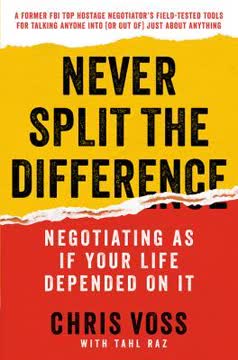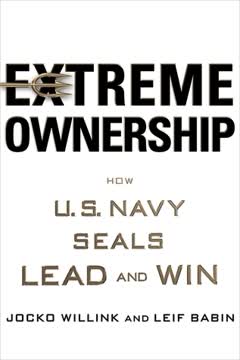Key Takeaways
1. Master Sales Negotiation: The Art of Winning for Your Team
Sales negotiation is about winning for your team while minimizing resentment at the same time; in sales, relationships matter.
Winning is paramount. Sales negotiation is not about creating "win-win" outcomes, but about securing the best possible deal for your company while preserving long-term relationships. This requires a delicate balance of assertiveness and empathy. Effective negotiators focus on:
- Protecting profits and commissions
- Delivering value to customers
- Maintaining positive stakeholder relationships
Resentment is toxic. Avoid negotiating tactics that create bitterness or contempt, as these emotions can poison future interactions and erode customer lifetime value. Instead, strive for outcomes that satisfy both parties' core needs and motivations.
2. Win First, Then Negotiate: Timing is Everything
Negotiation begins after the sales process ends and begins when the buyer or stakeholder group has selected you as the VOC.
Vendor of Choice (VOC) status is crucial. Attempting to negotiate before being selected as the preferred vendor weakens your position and often leads to unnecessary concessions. Key strategies include:
- Focusing on building value and differentiation throughout the sales process
- Recognizing implicit and explicit signals that you've been chosen
- Resisting pressure to negotiate prematurely
Avoid red herrings. Early attempts by buyers to discuss price or terms are often distractions. Use the PAIS framework (Pause, Acknowledge, Ignore, Save) to maintain control of the conversation and preserve your leverage for when it matters most.
3. Emotional Discipline: The Cornerstone of Effective Negotiation
In every negotiation, the person who exerts the greatest emotional control has the highest probability of achieving their desired outcome.
Master your emotions. The seven disruptive emotions that can derail negotiations are:
- Fear
- Desperation
- Insecurity
- Need for significance
- Attachment
- Eagerness
- Worry
Develop emotional resilience. Techniques for maintaining composure include:
- Practicing relaxed, assertive confidence
- Using the "ledge technique" to create a mental pause
- Leveraging noncomplementary behaviors to disrupt negative patterns
- Building "obstacle immunity" through intentional exposure to challenging situations
Remember that willpower and emotional discipline are finite resources. Avoid negotiating when tired, hungry, or emotionally drained.
4. Leverage and Power Position: Shaping the Negotiation Chessboard
Buyers are almost always in a stronger power position than sellers.
Understand the power dynamics. Buyers typically have more alternatives and less urgency, giving them an inherent advantage. To strengthen your position:
- Build a robust pipeline to reduce desperation
- Eliminate or neutralize the buyer's perceived alternatives
- Leverage scarcity and urgency when possible
- Develop strong relationships with key stakeholders
Use leverage wisely. Leverage is any asset that can compel behavior change. Never give it away for free; always exchange it for something of equal or greater value. Types of leverage include:
- Information
- Scarcity
- Relationships
- Time pressure
- Unique capabilities or solutions
5. Discovery: Building an Unassailable Business Case
Except for putting the right deals into the pipeline in the first place, nothing else in the sales process has a greater impact on your position at the sales negotiation table than effective discovery.
SCORE framework for discovery:
- S: Stakeholder success criteria
- C: Criteria for vendor evaluation
- O: Desired business outcomes and metrics that matter
- R: Real state situation
- E: End state vision
Dig deep. Effective discovery requires patience, strategic questioning, and active listening. Focus on:
- Uncovering hidden motivations and pain points
- Identifying metrics that matter to stakeholders
- Building a compelling value proposition based on measurable business outcomes
Use the information gathered to create a strong business case that differentiates you from competitors and neutralizes alternatives.
6. The DEAL Framework: Navigate Sales Negotiations with Confidence
Sales negotiation plans, like most battle plans, rarely survive first contact.
DEAL framework for agile negotiations:
- Discover: Clarify and isolate issues
- Explain: Bridge to value and justify your position
- Align: Deploy your Give-Take Playlist
- Lock: Secure commitments and get ink
Prepare thoroughly. Develop a Sales Negotiation Map (SNM) with:
- Target and limit zones
- Concession inventory
- Give-Take Playlist (GTP)
Be ready to adapt your strategy in real-time while maintaining focus on your objectives.
7. Align and Lock: Securing Agreements and Getting Ink
If you want to succeed in sales negotiations and get ink consistently, you must master the discipline of asking.
Master the art of asking. Confidently and directly ask for commitments throughout the sales process, especially when aligning on agreements. Common methods for locking down deals include:
- Obtaining payment
- Securing signed agreements or purchase orders
- Confirming verbal agreements with a handshake (when appropriate)
- Using letters of understanding (LOUs) for complex negotiations
Avoid assumptions. Just because a buyer nods or says "yes" doesn't mean you have a firm agreement. Always clarify and confirm specific terms before considering a deal closed.
Remember, there are no silver bullets or magic phrases that guarantee a close. Success comes from disciplined practice, emotional control, and a willingness to ask for what you want.
Last updated:
FAQ
What's Inked about?
- Sales Negotiation Focus: Inked by Jeb Blount is a comprehensive guide on effective sales negotiation tactics, emphasizing emotional discipline and understanding buyer psychology.
- Real-World Application: The book provides practical strategies for everyday sales scenarios, contrasting with high-stakes negotiations often depicted in other literature.
- Emotional Discipline: A significant theme is the necessity of emotional discipline in negotiations, crucial for achieving favorable outcomes.
Why should I read Inked by Jeb Blount?
- Master Negotiation Skills: The book helps develop essential negotiation skills, leading to more closed deals and increased commissions.
- Avoid Common Pitfalls: It highlights common mistakes, such as giving discounts too easily, helping you avoid them and improve outcomes.
- Build Confidence: Blount emphasizes confidence and emotional control, cultivating a mindset for effective negotiation.
What are the key takeaways of Inked by Jeb Blount?
- Win First, Then Negotiate: Secure your position as the vendor of choice before entering negotiations to maintain leverage.
- Emotional Control is Crucial: Managing emotions is vital for successful negotiations, preventing concessions made out of fear or desperation.
- Understand Stakeholder Dynamics: Mapping stakeholders and understanding their motivations helps tailor negotiation strategies.
What are the best quotes from Inked and what do they mean?
- "Effective negotiating begins and ends with emotional discipline.": Highlights the importance of managing emotions during negotiations for favorable outcomes.
- "Sales negotiation is about winning for your team.": Emphasizes securing the best outcome for your organization while maintaining relationships.
- "Never give leverage away for free.": Reminds salespeople to ensure concessions are exchanged for something of equal or greater value.
What is the DEAL Sales Conversation Framework in Inked?
- Four Key Steps: The DEAL framework consists of Discover, Explain, Align, and Lock, guiding sales professionals through negotiations.
- Focus on Discovery: The Discover phase involves uncovering the buyer's issues and concerns, crucial for understanding their needs.
- Alignment and Commitment: Align focuses on negotiating an agreement while protecting interests, and Lock ensures commitments are secured.
How does emotional discipline impact negotiations in Inked?
- Managing Disruptive Emotions: Emotional discipline helps manage emotions like fear and anger, which can negatively affect outcomes.
- Building Confidence: Maintaining emotional control allows sales professionals to present themselves with assertive confidence.
- Improving Decision-Making: It enables negotiators to make rational decisions rather than reactive ones, leading to better agreements.
What is the PAIS framework mentioned in Inked?
- Pause, Acknowledge, Ignore, Save: A strategy for managing red herrings during negotiations, maintaining control over the conversation.
- Maintaining Control: Helps avoid giving away leverage prematurely, keeping focus on negotiation objectives.
- Emotional Regulation: Aids in emotional regulation, allowing negotiators to respond thoughtfully rather than react impulsively.
How does Inked suggest handling objections during negotiations?
- Identify Objections Early: Recognizing objections as they arise prevents them from becoming major roadblocks later.
- Clarify Concerns: Clarifying what the stakeholder means helps in understanding underlying issues for a targeted response.
- Use Objections as Opportunities: Viewing objections as opportunities strengthens your case, building trust and demonstrating value.
What is the significance of the SCORE discovery framework in Inked?
- Structured Discovery Process: The SCORE framework helps gather essential information to build a compelling business case.
- Building Trust: Effective discovery fosters trust between the salesperson and the stakeholder, creating stronger relationships.
- Eliminating Alternatives: Identifies and addresses potential alternatives, strengthening your negotiating position.
How can I effectively use the Give-Take Playlist from Inked?
- Leverage Low-Cost Concessions: Identify concessions of low value to you but high value to the buyer for effective negotiation.
- Plan for Incremental Moves: Prepare a series of concessions and counteroffers to maintain leverage and encourage reciprocity.
- Focus on Value Exchange: Ensure every concession is met with something of equal or greater value, reinforcing mutual benefit.
What are some common buyer tactics discussed in Inked?
- Bullying Tactics: Buyers may use aggressive tactics to intimidate salespeople into quick concessions; recognizing these is crucial.
- Triggering Obligation: Flattery or emotional appeals create a sense of obligation, making it harder to refuse concessions.
- Red Herrings: Introducing irrelevant information distracts from negotiation, leading to unnecessary concessions if not managed.
How does Inked address the importance of preparation in negotiations?
- Thorough Planning: Entering negotiations without a solid plan can lead to unfavorable outcomes; preparation is key.
- Scenario Practice: Practicing various scenarios builds confidence and readiness for unexpected challenges.
- Sales Negotiation Map: A tool to outline strategy, ensuring focus and track during negotiations.
Review Summary
INKED receives high praise from readers for its insights into sales negotiation tactics. Reviewers appreciate the actionable advice, real-world examples, and psychological strategies presented. Many find it applicable beyond sales, to personal and professional relationships. Some criticize its repetitiveness and overuse of acronyms. Overall, readers value the book's emphasis on communication, value creation, and stakeholder alignment. It's considered a must-read for sales professionals looking to improve their closing rates and negotiation skills, with practical frameworks for various selling scenarios.
Similar Books










Download PDF
Download EPUB
.epub digital book format is ideal for reading ebooks on phones, tablets, and e-readers.













